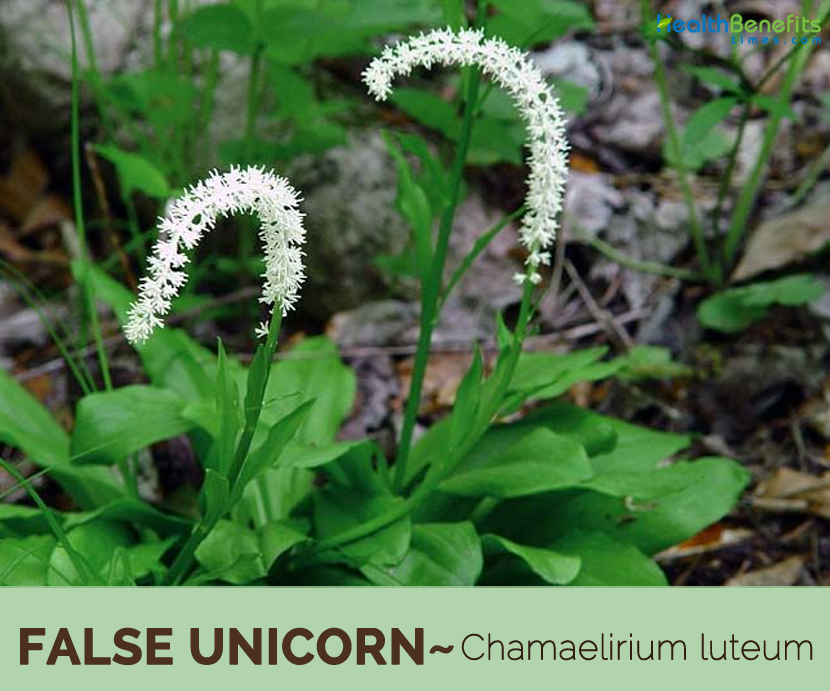
Plant Description
False Unicorn is an herbaceous dioecious perennial herb that grows about 30-100cm tall. Female stalks tend to be taller, giving a total maximum plant height of about 1.2 m, but also tend to have about ten times fewer flowers. It grows in a variety of habitats, including moist slopes, bottomlands, wet savannas, dry woods, barrens, and bluffs, typically absent from the eastern coastal plains. It also thrives in open woods and relatively open calcareous wet meadows. It prefers moist, well drained and acidic soil with high humus content. Stem is 1 to 3 feet high, simple, smooth, angular. Leaves are alternate, spatulate below, lanceolate above, radical leaves, 8 inches long, 1/2 inch wide, narrow at base and formed into a whorl.
Flower
Flowers are numerous, small, greenish white, bractless, dioecious, in a dense, terminal raceme, nodding like a plume, (1–1.5 cm diameter, 8–30 cm length), petals of such flowers narrow, stamens longer than the petals, filaments tapering; anthers terminal, two lobed; petals of female flowers linear; stamens short; ovary ovate, triangular, furrowed; stigmas three-capsule, oblong, three-furrowed, opening at summit. Flowering normally takes place from May to June. Male plants grow up to 2.5 feet tall, but female plants may grow as tall as 4 feet. Tiny flowers in spike-like terminal racemes appear in June. Flowers on the male plant grow in dense, arching, plume-like spikes (to 9” long). Flowers on the female plants are in smaller erect spikes. Female plants produce seed in 3-valved, ellipsoid capsules. The fruit is a loculicidal capsule, with several seeds appearing in each locule.
History
Chamaelirium luteum is used both medicinally and as an ornamental plant. Called “helonias” in the medicinal and herbal literature, C. luteum was used by American Indians and by 1917 was considered one of the more widely used domestic drugs in North America. Medicinal uses include treatment of colic, stomach ailments, indigestion, the expulsion of worms, stimulation of appetite, and a variety of ailments associated with both male and female reproductive organs. False Unicorn Root contains estrogenic compounds.
Traditional uses and benefits of False Unicorn
- It was traditionally used to prevent miscarriages and it has the reputation of improving fertility.
- Nowadays it is used to treat different problems as menstrual problems, pregnancy complaints, fertility issues, ovarian cysts and diuretic.
- It is a traditional remedy of the North American Indians where it was used mainly as a woman’s herb.
- It is widely used in Western herbal medicine where it is seen as a balancing herb for the female reproductive system and has proved to be a beneficial remedy for menstrual problems and ovarian cysts – it can also be of help in the menopause.
- Root is adaptogen, diuretic, emetic, uterine tonic and vermifuge.
- Small doses of the dried and powdered root are used.
- It is used in the treatment of amenorrhea, dysmenorrhea and leucorrhoea and also for a variety of ailments associated with the male and female reproductive organ.
- It is useful in impotence, as a tonic in genito-urinary weakness or irritability, for liver and kidney diseases.
- It is a good remedy in albuminaria.
- The herb is considered to be effective in treating amenorrhea.
- It is also noted for its ability to relieve the symptoms of morning sickness.
- False unicorn may help improve low sex drive in some women.
- It appears to improve the secretory responses and cyclical functions of the ovary and appears to have a beneficial action on that organ.
- It is believed to be useful in the treatment of impotence.
- Its tonic properties are of benefit to the treatment of lack of appetite and digestion.
- It also suggests the ability to kill and help expel tape worms.
- False unicorn has been renowned as an effective diuretic.
- It is effective in the treatment of headaches and even depression.
- False unicorn combines well with echinacea for the treatment of chronic pelvic inflammation.
- False unicorn is supposed to be helpful in the prevention of miscarriage.
- It increases the urination and treats water retention.
https://www.youtube.com/watch?v=zONEtYmZJls
Ayurvedic Health benefits of False Unicorn
- Uterine Bleeding: Prepare a root infusion of False Unicorn. Drink 30 ml once a day.
- Repeated Miscarriage: Boil false unicorn root in a cup of water. Drink 20 ml of it twice a day.
- Infertility: Take 2 tsp of dried False Unicorn root and boil it for 10 min in water. Strain and drink this tea 2 times in a day.
- Menstrual Disorders: Make a decoction of false unicorn root and life root. Take it two times a day.
Other Facts
- luteum is used as ornamental or medical herb.
Precautions
- This plant is a cardiac toxin in large quantities.
- Large doses may cause nausea & vomiting.
- Chamaelirium luteum is an emenagogue (promotes menstruation) so best avoided during pregnancy.
References:
https://www.itis.gov/servlet/SingleRpt/SingleRpt?search_topic=TSN&search_value=42894#null
http://davesgarden.com/guides/pf/go/1992/
http://www.pfaf.org/user/Plant.aspx?LatinName=Chamaelirium+luteum
http://www.botanical.com/botanical/mgmh/u/unifal01.html
https://plants.usda.gov/core/profile?symbol=chlu
http://www.theplantlist.org/tpl/record/kew-302082
https://www.frostburg.edu/fsu/assets/File/ACES/chamaelirium%20luteum%20-final.pdf
https://en.wikipedia.org/wiki/Chamaelirium
Comments
comments